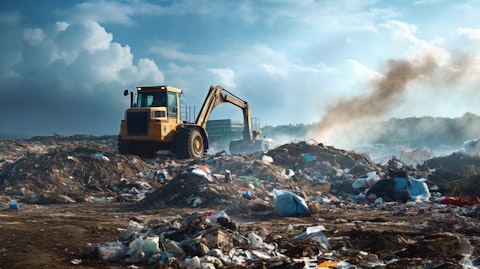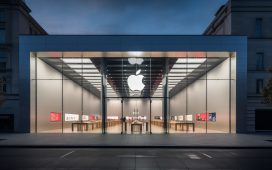GFL Environmental Inc. (NYSE:GFL) Q1 2024 Earnings Call Transcript May 4, 2024
GFL Environmental Inc. isn’t one of the 30 most popular stocks among hedge funds at the end of the third quarter (see the details here).
Operator: Good morning, ladies and gentlemen. And welcome to the GFL Environmental 2024 First Quarter Earnings Call. My name is Glenn, and I will be the operator of today’s call. At this time, all participants will be in a listen-only mode. [Operator Instructions] I will now hand you over to your host, Patrick Dovigi, Founder and CEO of GFL Environmental. Patrick, you may now begin.
Patrick Dovigi: Thank you and good morning. I would like to welcome everyone to today’s call and thank you for joining us. This morning we will be reviewing our results for the quarter. I am joined this morning by Luke Pelosi, our CFO, who will take us through our forward-looking disclaimer before we get into details.
Luke Pelosi: Thank you, Patrick. Good morning, everyone, and thank you for joining. We have filed our earnings press release, which includes important information. The press release, as well as a presentation to accompany this call, is available on our website. During this call, we will be making some forward-looking statements within the meaning of applicable Canadian and U.S. securities laws, including statements regarding events or developments that we believe or anticipate may occur in the future. These forward-looking statements are subject to a number of risks and uncertainties, including those set out in our filings with the Canadian and U.S. securities regulators. Any forward-looking statement is not a guarantee of future performance and actual results may differ materially from those expressed or implied in the forward-looking statements.
These forward-looking statements speak only as of today’s date and we do not assume any obligation to update these statements, whether as a result of new information, future events and developments or otherwise. This call will include the discussion of certain non-IFRS measures. A reconciliation of these non-IFRS measures can be found in our filings with the Canadian and U.S. securities regulators. I will now turn the call back over to Patrick.
Patrick Dovigi: Thank you, Luke. Once again, we started the year with the strength of our high-quality employees and asset-based driving performance ahead of expectations. This is our fifth year of being a public company and I continue to be humbled by the capacity of more than our 20,000 employees to consistently deliver results ahead of our plans. On our last call, in what has become our usual practice, we provided our 2024 guidance with an industry-leading degree of transparency and the details of the moving pieces that we anticipated this year, including what we expected to be industry-leading organic margin expansion in our base business. We also outlined the specifics of our planned M&A and growth investments. Our first quarter results are better than we guided and we fully expect this positive momentum to continue for the balance of the year.
Luke will walk us through the details, but I wanted to first highlight a few key metrics. First quarter pricing was 7.7% on a like-for-like basis. Our pricing strategies continue to outperform expectations and we remain optimistic about our ability to realize incremental pricing opportunities as we replicate the pricing playbook that our public company peers have already successfully employed. With the strength of our first quarter pricing, we are highly confident that we will be able to meet or exceed our price guidance for the year. We expect the recent strength in commodity prices to continue to be upside versus our guidance. On the cost side, labor turnover is sequentially improving and is yielding efficiencies in onboarding cost, productivity and the overall cost of risk.
R&M costs are also improving as unit cost inflation moderates and fleet replacement rates improve. The result is the realization of outsized price-cost spread that supports ongoing margin expansion. Volume growth in the quarter was negative 3%. This was significantly better than our expectations as the negative impact on volume of the unusually cold January weather in our southern markets was offset by the positive impact of milder weather in most of our northern markets in February and March. We expect some of this could be a pull-forward of second quarter volumes. However, we remain confident in our full year volume expectations, including our guidance. We also remain confident in the effectiveness of our deliberate volume strategies. As we’ve discussed, our industry-leading growth has provided us outsized opportunities to improve asset utilization and drive margin expansion through the internal — intentional shedding of lower-quality revenues.
We believe the benefits of these strategies are evident in our margin performance. As we highlighted on our year-end call, we are also actively deploying growth capital across a variety of initiatives that we expect will generate significant ROIC for years to come. In the first quarter, we deployed $62 million into incremental growth investments, primarily related to recycling and RNG infrastructure. For the full year 2024, we remain on track to deploy $250 million to $300 million into these investments, as we previously guided. The EPR landscape in our Canadian markets continues to evolve and we remain confident that we will see upside to the $80 million to $100 million of incremental adjusted EBITDA we previously identified associated with these initiatives.
As we said earlier, the contribution from these contracts is expected to start late this year, ramp up through 2025 and achieve our expected full contribution in fiscal 2026. On RNG, our first facility at the Arbor Hills Landfill is continuing to ramp up its operations, generating cash flow in line with our expectations. We have two or three more facilities that we’ll expect to come online by the end of the year. We remain confident that we will realize the $175 million of adjusted EBITDA previously disclosed once our portfolio of landfill gas to energy facilities is fully operational in the coming years. In addition to organic growth initiatives, we have deployed approximately $500 million into six acquisitions since the beginning of this year.
All these acquisitions were in solid waste within our existing geographies. The largest of the six acquisitions we discussed in our last earnings call is a vertically integrated asset in Central Florida, one of the fastest growing markets in the U.S. This asset is highly complementary to our existing network and we expect that it will act as a driver for significant organic growth for us in this market for years to come. Like most acquisitions of this caliber, the M&A process commenced over six months before closing and the consummation of this transaction was fully anticipated when we provided our capital allocation framework in November of last year. While we continue to maintain a robust acquisition pipeline, we remain absolutely committed to the guidance for our total 2024 growth investments and net leverage that we set out at the beginning of the year.
As we have consistently demonstrated, the predictable recurring nature of the revenues and cash flows generated by our business allow us to forecast the full year’s results with a high degree of accuracy. Within a given year, weather-driven timing differences between the first and second quarters can impact comparability on a year-over-year basis, and therefore, we typically have waited until the first half of the year to give updated guidance for the year. While we believe there could be some revenue pull-forward from the second quarter because of weather-related impacts, based on the quality of the margin performance in the first quarter, we are increasing our guidance for 2024 adjusted EBITDA to $2.23 billion. We will provide a more fulsome guidance update when we report our second quarter results.

I’ll now pass the call to Luke, who will walk us through the quarter in more detail and then I’ll share some closing comments before we open it up for Q&A.
Luke Pelosi: Thanks, Patrick. Our accompanying investor presentation provides supplemental analysis to summarize performance in the quarter in a consistent format to what we’ve previously provided. Revenue for the quarter of $1.8 billion was 6.5% higher than the prior year, excluding the impact of the solid waste divestitures. Stronger-than-anticipated pricing and volume were the primary drivers of this result that was $25 million ahead of internal expectations. While the January cold weather in our southern markets negatively impacted volumes, the above-average temperatures later in the quarter in many of our northern U.S. and Canadian markets partially offset the January impacts. As Patrick said, the strength of our first quarter pricing activities is highly encouraging for the achievement or exceedance of our pricing expectations for the year, with over 80% of our full year pricing impact already locked in based on the contracted nature of our business.
Page 3 shows the bridge for solid waste adjusted EBITDA margins compared to the first quarter of 2023. As anticipated, the change in commodity and fuel prices from the prior year served as a margin tailwind, whereas the net contribution of M&A and divestitures was a 20-basis-point margin headwind versus the first quarter of 2023. Underlying solid waste margins expanded by 100 basis points, 50 basis points better than planned, a result that would have been even greater without the weather-related impacts. The flow-through benefits of the outsized price-cost spread, our intentional volume-shedding initiatives, RNG contribution and incremental operating leverage coming from improving employee turnover and asset utilization are exceeding expectations and reinforce our optimism and our ability to exceed the industry-leading organic margin expansion we included in our base guide for this year.
Page 4 highlights the performance of our Environmental Services segment in the quarter. To contextualize this year’s performance, it is important to recall the prior year comparable period saw an unseasonably high level of activity, resulting in 25% organic revenue growth in that quarter. We had called out this outsized performance in our Q1 2023 reporting. Normalizing the prior period for this outperformance, we saw over 10% topline revenue growth in this segment. Unusually cold weather in the south in January, as well as the imposition of earlier spring road weight restrictions because of warmer weather in our northern markets that are typically implemented in the second quarter, negatively impacted volumes. The impacts on our southern markets alone impacted margins by over 100 basis points.
The rollover impact of the fire we had at one of our facilities in late Q4 was a 20-basis-point drag on ES margins. The timing of event-driven work and the sale of used motor oil also resulted in reduced revenue versus the prior year. The fact that we are exceeding our margin expectations in the face of these headwinds serves to highlight the quality of the underlying portfolio and our overall growth strategy for this segment. Adjusted free cash flow for the quarter was $49 million, an increase of nearly $100 million over the prior year period and ahead of our internal expectations. The outperformance of adjusted EBITDA, a lower seasonal investment in working capital and capital expenditures that were $25 million less than the plan all contributed to the significant outperformance versus expectations.
We expect the working capital and CapEx variances to be timing differences and remain confident in our full year expectations for both of these line items. Page 5 summarizes reported net leverage, which was 4.3 times on March 31st, reflecting the impact of normal core seasonality and the change in FX rates from the start to the end of the quarter. During the quarter we received a credit rating upgrade from S&P and remain on positive credit watch from both the rating agencies, reflecting the material improvement in our credit quality and the expectation for further improvement in the near term. As we previously said, we anticipate material credit rating upgrades prior to the maturity of most of our existing debt, providing an opportunity for near-term lower borrowing costs and improved free cash flow conversion.
As Patrick said, we remain absolutely committed to our previously stated leverage targets and with the strength of the first quarter performance, we are confident in our ability to achieve these targets, exiting 2024 with net leverage between 3.65 times and 3.85 times. In terms of guidance, with the strength of this year’s start, we’re feeling highly confident in our ability to exceed our previously communicated targets. As Patrick said, the strength of the first quarter’s margin performance allows us the confidence to increase our adjusted EBITDA guidance to $2.23 billion. However, as Patrick noted and we’ve consistently said, there can often be timing shifts between the first and second quarters, so we will maintain our normal course practice of waiting until July before we formally update our full set of guidance for the year.
Specifically related to the second quarter, we note the following. Consolidated revenue is expected to be approximately $2.055 billion. Solid waste revenues are expected to be $1.56 billion to $1.57 billion, driven by pricing just over 6% and volume that’s anticipated to improve approximately 50 basis points sequentially from the first quarter, or approximately negative 2.5%. For Environmental Services, we expect to realize between $475 million and $500 million of revenue, representing another quarter of 10% growth over the prior year. The wider-than-typical revenue ranges within the segments are to account for the potential weather-driven pull-forward of revenue into the first quarter from Q2. In terms of margin, we expect consolidated adjusted EBITDA margins to accelerate over 300 basis points sequentially over the first quarter to just under 28.5% or nearly 70 basis points over Q2 2023.
At the segment level, this assumes solid waste margins of 32.25% to 32.5%, ES margins of almost flat with the prior year around 29.6% and corporate margins of negative 3.2%. The guide then contemplates further margin expansion in the third quarter before stepping down in the fourth quarter as per the typical cadence of the business. Putting that together yields between $585 million and $590 million of adjusted EBITDA for the second quarter. Additionally, we expect $220 million to $230 million of net capital expenditures, $105 million of cash interest, an investment in working capital between $65 million and $75 million, and other operating items of approximately $25 million for Q2 adjusted free cash flow of approximately $160 million to $170 million.
In terms of net leverage, we expect a modest step up in Q2 as a result of seasonality and completed M&A and then to rateably step down in Q3 and Q4. Adjusted net income is expected to be approximately $100 million for the second quarter. I will now pass the call back to Patrick, who will provide some closing comments before Q&A.
Patrick Dovigi: Thanks, Luke. The drive of our employees to make our business better every day is evident in what we have achieved this quarter and the opportunities we are creating for steadily improving performance in the near and longer term. I want to thank each and every one of them for their dedicated contribution to Team Green. As I’ve said on many of our calls, our focus has always been on delivering what we say we’re going to do. This quarter is no exception. Our results for the quarter continue to demonstrate the underlying quality of our asset base and the impact of the effective and consistent implementation of our key value creation strategies. At the same time, the discipline-targeted growth investments we are making today are setting us up to deliver strong organic growth for many years to come.
We have provided comprehensive, easy-to-follow guidance for the year and we’ve started off 2024 delivering on exactly what we said we were going to do. We intend to continue to do more of the same in the coming quarters. I will now turn the call over to the Operator to open the line for Q&A.
See also 25 Most Profitable Companies in the US and 12 Most Unfriendly Cities in Canada.
Q&A Session
Follow Gfl Environmental Inc. (NYSE:GFL)
Follow Gfl Environmental Inc. (NYSE:GFL)
Operator: Thank you. [Operator Instructions] With our first question comes from Stephanie Moore from Jefferies. Stephanie, your line is now open.
Stephanie Moore: Hi. Good morning. Thank you.
Patrick Dovigi: Good morning.
Stephanie Moore: To start, could you give us an update on this EPR? Patrick, you mentioned upside to the $80 million to $100 million of EBITDA. Where are you seeing the additional opportunities and what is the timing? Thanks.
Patrick Dovigi: Yeah. So, I think, as we discussed, the $80 million to $100 million of incremental EBITDA is in the bag today, signed, contracted, et cetera. As we said, there was — there’s a few large, particularly hauling and transfer contracts that were out for bid sort of late last year. We have been notified that we have been selected as a preferred vendor for the entire city of Toronto on the recycling side. It’s not done as of yet, but we are in contract negotiations to finalize that and hope to have a very good update for you on our Q2 call. As well, there’s a multitude of other sort of residential contracts. Mostly the ones we’re focused on is one that we actually already currently do and we expect that those will be awarded over the next sort of three to four months.
So, again, pretty good opportunity and upside from those. And as we look at the other provinces, Quebec and the Maritimes continue to release incremental bids and legislation continues to go through in Western Canada. But I think, you know, on the Q2 call, we’ll give you sort of a very good update on where we stand with EPR. But very good news on our side that we were notified of being the preferred vendor for contract negotiations for the entire city of Toronto.
Stephanie Moore: Got it and that’s helpful. And then this is a follow-up. Maybe, Luke, free cash flow was much better than expected for the quarter and it looks like you are seeing some improvements in working capital management. Where are you in that process and kind of what are your expectations for working capital cadence for the remainder of the year? Thanks.
Luke Pelosi: Yeah. Thanks, Stephanie. It’s a great question and certainly an area where we do see continued opportunity. I mean, for context, you’ve got to remember, I mean, working capital with the levels of M&A we’ve done historically, sometimes you can have impacts of that that, manifest in the working capital line and therefore harder to sort of smooth that out over the four quarters. As we now have the stability of the base business, it allows for more sort of regular cadence. So with the seasonality profile of our business, primarily the northern markets, we’re going to continue to see investments in the first half that then reverse in the second half. However, as you can see in this quarter, the magnitude of the swing is becoming more and more muted.
So it’s going to allow for much more predictable and stable free cash flow generation on sort of quarter-over-quarter basis and you’re seeing that in this quarter’s results. So we do think this year’s cadence will be similar. Q2 we’ll see another investment, albeit at a lower level than historically, and then the reversals that we’ve customarily realized in Q3 and Q4 are expected as well.
Stephanie Moore: Great. Thanks so much.
Operator: Thank you. With our next question comes from Kevin Chiang from CIBC Wood Gundy. Kevin, your line is now open.
Kevin Chiang: Hey. Thanks for taking my questions. Maybe just on the rest of the M&A spend this year, I just want to make sure I have this correctly. So it looks like you spent just over $111 million in Q1, which doesn’t look like it includes the Angelo acquisition, which I think on the last call you suggested a sizable acquisition would be about half the expected spend this year. So it looks like you’re about two-thirds, if my math is correct, about two-thirds of the way through the $600 million to $650 million of M&A spend this year. Just wondering, one, is my math correct? And then two, just the visibility on spending the rest of that capital, is that something we should expect in the second quarter here or does that kind of smooth out through the rest of the year, just given how active you’ve been through the first four months of this year?
Patrick Dovigi: Yeah. So I think we spent year-to-date about $500 million, so it leaves somewhere between $100 million and $150 million spend for the sort of rest of the year. I think you’ll see some of that trickle in in later Q2 and spread out through Q3 and early Q4. But I wouldn’t expect it all to sort of be spent by the end of Q2. It’s going to trickle into the next couple of quarters.
Luke Pelosi: Yeah. And Kevin, in terms of the financial statements, you have it right. Q1 saw four acquisitions closed, but Angelo’s the largest and another were closed actually the beginning of April. So it’s in that year-to-date number that Patrick said, but within the quarter proper you had the lower spend on just those four smaller acquisitions.
Kevin Chiang: That’s helpful. And maybe just a second one for me and I appreciate you’ll provide a more fulsome update on the full year guide when you report Q2 and you talked about wanting to see some of the impact maybe on volumes shifting between Q1 and the second quarter here. But I guess if I look at it simplistically, you assumed a level of seasonality in Q1 in your previous guidance. If I apply that seasonality to what you actually printed in Q1, plus adding in some of this M&A, which you haven’t included in your guidance, plus maybe a more favorable commodity price environment than you had assumed, because you’re pretty conservative, it feels like it’s a pretty sizable increase versus where you’re sitting now.




